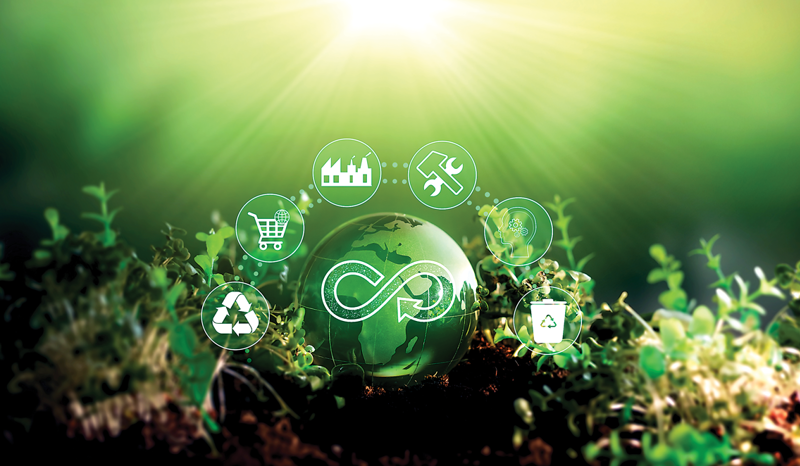The circular economy offers a revolutionary method for rethinking how resources are managed, products are produced, and consumption is structured, all with the goal of minimizing greenhouse gas (GHG) emissions. Current strategies such as transitioning to renewable energy and enhancing energy efficiency address only 55 per cent of global emissions. The circular economy complements these efforts by targeting the remaining 45 per cent, which is particularly critical for material-intensive industries such as cement, plastics, steel, aluminum, and food production.
A circular economy operates as a sustainable development model by keeping resources, products, and materials in use within production and consumption cycles for as long as possible. This approach optimizes resource utilization, significantly reduces waste, and lowers GHG emissions, outperforming the traditional linear economic model, which is characterized by the extraction, use, and disposal of resources in a wasteful manner.
Presence across industries
Amid growing climate change challenges, the circular economy offers a solution to resource depletion, carbon waste management, and sustainable growth. Carbon waste, a major driver of GHG emissions, requires effective management to meet global reduction targets under the Paris Agreement and the United Nations’ Sustainable Development Goals (SDGs). The circular economy tackles this by eliminating waste, extending material lifespans, and regenerating ecosystems, creating opportunities to reduce emissions by redesigning products and processes for better resource efficiency and lower carbon output.
The circular economy also emphasizes carbon recycling and reuse through biological and chemical processes. In biological applications, seaweed can be utilized to capture CO₂ and transform it into biofuels or raw materials, as seen in Iceland. This marine biotechnology not only reduces atmospheric CO₂ but also creates economic value from the recycled carbon. In agriculture, circular practices promote the use of organic fertilizers derived from carbon waste, improving soil quality and increasing its capacity for carbon sequestration. This closed-loop system recycles carbon instead of releasing it into the atmosphere.
The circular economy goes beyond recycling by focusing on ecosystem regeneration through nature-based solutions. Mangrove forests, for example, absorb carbon at three to five times the rate of other forests and offer vital benefits like coastal protection and biodiversity conservation. Restoration efforts in countries like Indonesia sequester millions of tons of CO₂ annually while boosting resilience against extreme weather. In urban areas, green infrastructure such as parks, green roofs, and ecological corridors enhance CO₂ absorption, reduce the urban heat island effect, and improve air quality.
Holistic approach
The circular economy has shown remarkable promise in promoting sustainable development and addressing pressing environmental issues. However, realizing its potential, particularly in carbon waste management, comes with significant challenges.
One of the most notable hurdles is the high upfront investment required for carbon recycling and reuse technologies, especially in developing countries. Innovations like CCUS or manufacturing with recycled materials demand substantial financial resources and depend heavily on government support to achieve large-scale implementation.
Another major barrier is the absence of a clear regulatory framework and supportive policies. To encourage the adoption of circular economy practices, countries need to introduce tax incentives, enforce mandatory recycling measures, and establish sustainable production standards that incentivize businesses to engage in circular economic activities.
Public awareness poses yet another challenge. Despite the evident economic and environmental advantages of a circular economy, many consumers and businesses lack adequate knowledge or fail to appreciate the long-term value of adopting such strategies.
Addressing this requires comprehensive education and awareness campaigns to foster sustainable consumption behaviors. Simultaneously, building a skilled workforce in fields like recycling, eco-design, and waste management is essential for facilitating this transition.
Global initiatives have proven that the circular economy is not merely an economic concept but a practical strategy for reducing emissions and preserving natural resources.
By embracing circular economy principles, nations and businesses can contribute significantly to achieving SDGs, such as SDG 12 on sustainable production and consumption, SDG 13 on climate action, and SDG 15 on land resource protection and biodiversity. Integrating practices like recycling, reuse, and ecosystem restoration into economic activities can generate enduring economic, environmental, and social benefits.
The path to success, however, requires strong collaboration between governments, industries, and communities, alongside policy frameworks, technological innovation, and investments in research and development. With these combined efforts, the circular economy can serve as a transformative tool for carbon waste management and pave the way for a sustainable future.
Integrating into carbon waste management
The adoption of circular economy principles for carbon waste management in Vietnam offers significant potential, particularly through shifts in consumption habits, especially among higher-income groups. Strategies such as reducing average living space per capita, encouraging car-sharing, and extending the lifecycle of products like clothing can help lower resource consumption and waste production.
Achieving these changes on a larger scale requires coordinated efforts, including raising public awareness, promoting service-based business models over personal ownership, and implementing supportive policies that incentivize sustainable consumer behavior. Urban planning can also play a transformative role by designing resource-efficient and sustainable cities. Measures such as reducing unused building spaces, expanding green public transport networks, and creating adaptable urban environments contribute to reducing resource use and carbon emissions.
Vietnam has started drafting policy frameworks to support the development of circular cities, which aim to reduce waste and lower carbon footprints. The success of this strategy relies on strong collaboration between government entities, businesses, and local communities, working together to build a sustainable and zero-waste future.
A critical aspect of carbon waste management in Vietnam is embedding circularity into the design phase of products. Resource-efficient designs, particularly in the construction and transportation sectors, can significantly cut carbon emissions. By focusing on creating durable and recyclable products, circular economy principles help reduce waste and preserve resources.
Since current market mechanisms do not sufficiently encourage sustainable product design, policies play an indispensable role. For instance, the European Commission’s eco-design regulations require products to meet standards of durability and recyclability. Vietnam can follow suit by establishing tools, standards, and regulations for construction, materials, and building circularity assessments. These frameworks would promote resource-efficient designs and the reuse of construction components, fostering sustainable development.
Applying circular economy concepts to carbon waste management in Vietnam, particularly in clean energy value chains, remains an emerging but highly promising area. Current efforts primarily focus on recycling at the end of a product’s lifecycle, leaving much of the potential for environmental and social benefits untapped throughout the value chain.
To accelerate the sustainable growth of clean energy value chains, robust partnerships between businesses, governments, non-governmental organizations (NGOs), and researchers are essential. A shared vision and coordinated actions are required to incorporate circular strategies into every stage of the clean energy value chain, from production and consumption to reuse and recycling. Such integration can scale up clean energy adoption while minimizing environmental and societal impacts.
The success of circular economy initiatives in carbon waste management in Vietnam hinges on their integration into national climate policies and strategies. There is increasing advocacy for embedding circular approaches within these frameworks to maximize their effectiveness. While waste management is an important step, implementing systemic circular strategies that consider the entire product lifecycle and apply across multiple industries, spanning production, consumption, and recycling, will deliver the most significant outcomes.
By integrating these strategies, Vietnam can pave the way towards a green and sustainable economy, achieve substantial reductions in GHG emissions, and comprehensively safeguard its environment for future generations.
Incorporating into national climate strategies
To effectively implement a circular economy in carbon waste management, Vietnam must prioritize reducing cross-border GHG emissions through robust accountability frameworks. Presently, many GHG reduction policies are confined to domestic or regional emissions, often leading to carbon leakage as carbon-intensive activities shift to other countries.
To create a sustainable emissions reduction strategy, it is crucial to develop cross-border accountability mechanisms. These should provide a comprehensive assessment of the impacts of circular economy strategies. Combining consumption-based emissions accounting, which measures the emissions embedded in the lifecycle of products consumed domestically, with production-based methods and sustainable supply chains offers a more holistic view. This approach ensures accurate and actionable insights for reducing emissions on a global scale.
Integrating cross-border emissions accounting into Vietnam’s national climate strategy will enhance the effectiveness of GHG reduction efforts and support the global advancement of circular economy principles.
Moreover, aligning circular economy metrics with climate change impacts is essential for optimizing emissions reduction strategies. Identifying the right metrics and setting clear, actionable targets maximize the benefits of mitigation efforts, foster environmental and socio-economic improvements, and create sustainable employment opportunities.
Advances in modeling and impact assessment enable stakeholders to adopt science-driven approaches for determining critical circular economy metrics. These insights support setting realistic goals for reducing GHG emissions and promoting sustainable growth.
While circular economy strategies are pivotal for climate change mitigation, enhancing climate adaptation is equally important. Achieving this balance requires the integration of environmental, economic, and social frameworks. Circular economy approaches help slow environmental degradation by reducing raw material demand, preserving natural habitats, mitigating flood risks, and stabilizing temperatures.
However, understanding the role of circular economy strategies in climate adaptation remains limited. More research is necessary to uncover how these approaches can best support adaptation processes, yielding significant benefits for both ecosystems and communities.
(* ) Associate Professor Nguyen Dinh Tho and Mr. Ha Quoc Dung are from the Institute of Strategy and Policy on Natural Resources and Environment at the Ministry of Natural Resources and Environment.









 Google translate
Google translate